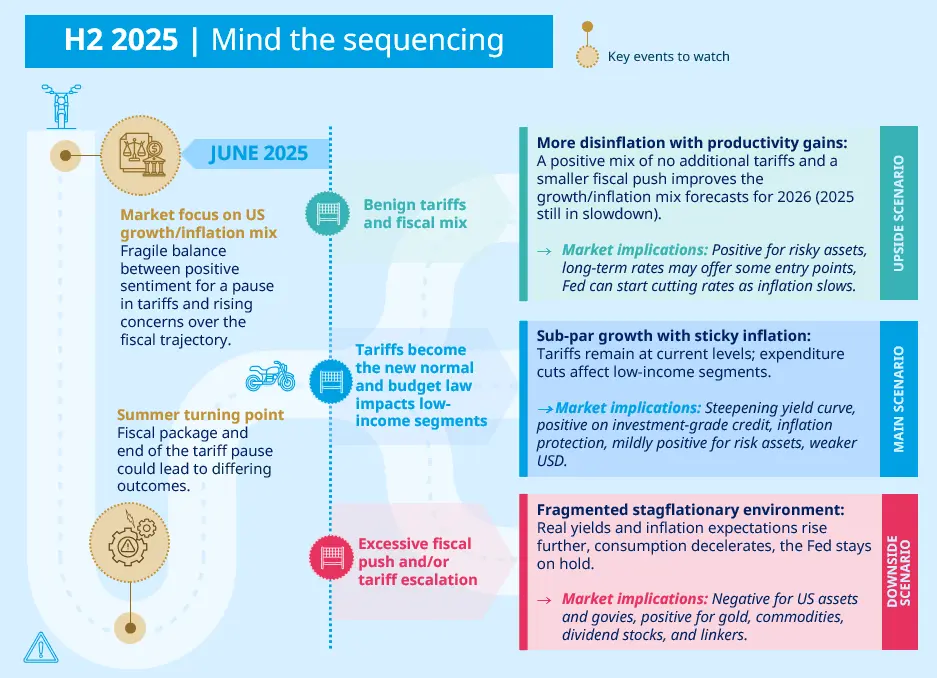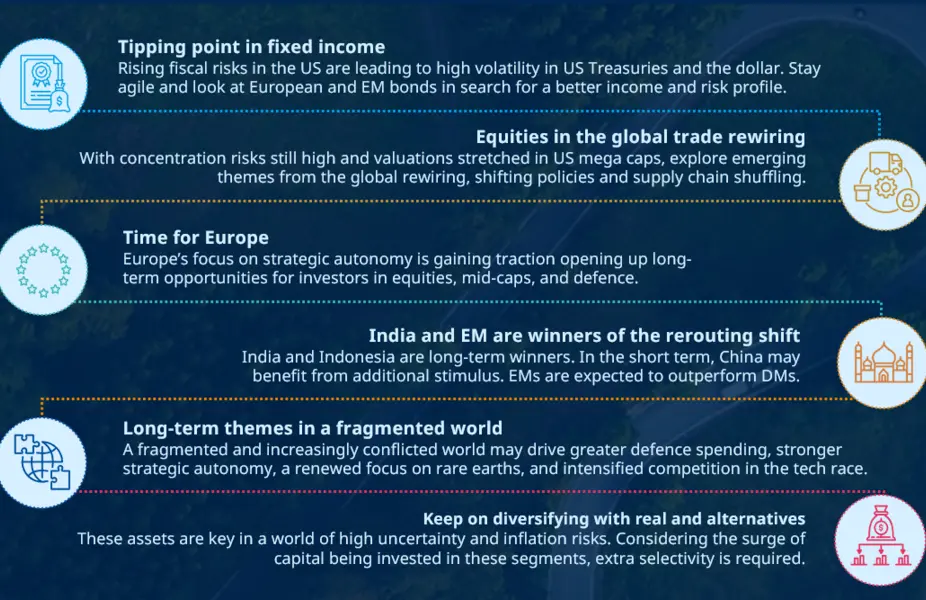You are accessing the web site as a professional investor and accept the below conditions
Important legal information. Please read these terms and conditions carefully.
You are about to enter the website of Amundi Hong Kong Limited. It is important that you read this page before continuing. By accessing this website and any pages thereof, you are indicating that you have read, acknowledge and agree to be bound by these terms of use. If you do not agree to these terms, please do not access this website or any pages thereof.
Amundi Funds
-
Amundi Funds is an umbrella structure that contains different sub-funds including equity sub-funds, bond sub-funds, and multi-asset sub-funds, each with different risk profile
-
Some sub-funds may invest in a single country or specific industry sector. The investment focus of the sub-funds may give rise to higher concentration risk. These sub-funds are likely to be more volatile than sub-funds with a broader range of investment.
-
Although some sub-funds will not make extensive use of derivatives for investment purposes or use complex derivatives or strategies, the use of derivatives and/or mortgage-backed securities (MBS) and asset-backed securities (ABS) may lead to exposure to credit risk of the issuer, liquidity risk, counterparty risk, valuation risk and over-the-counter transaction risk. Exposure to financial derivative instruments (FDI) and its leverage element may lead to higher risk of significant loss by the sub-fund. For some sub-funds may make extensive use of derivatives for investment purposes or use complex derivatives or strategies, which may additionally subject to higher leverage and volatility risks.
-
Some sub-funds may expose to a higher degree of risk due to the investment in small and medium companies.
-
Some sub-funds may focus in investing in emerging markets which may experience political, economic and regulatory changes which pose additional risk to the funds. These sub-funds are likely to be more volatile and less liquid than sub-funds which invest in developed countries.
-
Some sub-funds may invest in bonds and/or emerging markets green bond which may expose investors to interest rate, credit and prepayment risk. It may also associate economic risks of high inflation and interest rates, large external debt, political and social uncertainties as well as risk associated with emerging markets green bonds.
-
Some sub-funds may invest in convertible bonds, high yield, non-investment grade and unrated securities which are subject to higher risks including but not limited to default, downgrading, interest rate, credit and liquidity risks.
-
For RMB class, as RMB is not freely convertible, the investment in RMB classes may be adversely affected by the fluctuation in the exchange rate between RMB and other foreign currencies and the liquidity of RMB at the relevant time. In case of sizable redemption requests for the RMB classes, the Manager has the absolute discretion to delay any payment of redemption requests from the RMB classes.
-
For distribution class, the Manager may at its discretion determine to pay dividends out of income or capital or effectively out of capital of the fund. Payment of dividends out of capital and/or effectively out of capital amounts to a return or withdrawal of part of an investor’s original investment or from any capital gains attributable to that original investment. Any distributions involving payment of dividends out of the fund’s capital or payment of dividends effectively out of the fund’s capital (as the case may be) may result in an immediate reduction of the net asset value per share of the fund.
-
The value of the fund can be extremely volatile and could go down substantially within a short period of time. It is possible that your investment value could suffer substantial loss.
-
The investment decision is yours, but you should not invest in the product unless the intermediary who sells it to you has advised you that the product is suitable for you and explained why including how buying it would be consistent with your investment objective.
Amundi Asia Funds
-
Amundi Asia Funds is an umbrella structure that contains different sub-funds. The sub-funds are funds of funds that will invest at least 80% of their net assets in UCITS (undertaking for collective investment in transferable securities) / UCIs (undertaking for collective investment).
-
Investing in this fund may expose investors to exchange/currency risk, concentration risk, emerging markets risk, Eurozone risk.
-
Some sub-fund(s) may involve risks relating to Standard Chartered’s CIO selection strategy, termination of the right to use Standard Chartered’s CIO selection strategy, risks associated with debt securities (including credit/counterparty risk, interest rate risk, below-investment-grade/unrated bonds risk, sovereign debt risk, volatility and liquidity risk, downgrading risk, valuation risk and credit rating risk), as well as risk of investment in collateralised and/or securitised products.
-
Some sub-fund(s) may involve risks of investing in other schemes, risk relating to the investment strategy of the fund, risk of termination of the investment advisory agreement with DBS, as well as risks associated with debt securities (including credit/counterparty risk, interest rate risk, sovereign debt risk, below-investment-grade bonds risk, volatility and liquidity risk, downgrading risk, valuation risk and credit rating risk).
-
The fund may invest in underlying schemes which may use FDI extensively for investment purposes, or of which the net derivative exposure is more than 50% of the underlying schemes’ net asset value. Investment in FDI is subject to additional risks, including counterparty and credit risk, liquidity risk, valuation risk, volatility risk and over-the-counter transaction risk. The leverage element/component of an FDI may result in significant losses.
-
For distribution class, the fund may at its discretion determine to pay dividends out of income or capital or effectively out of capital of the fund. Payment of dividends out of capital and/or effectively out of capital amounts to a return or withdrawal of part of an investor’s original investment or from any capital gains attributable to that original investment. Any distributions involving payment of dividends out of the fund’s capital or payment of dividends effectively out of the fund’s capital (as the case may be) may result in an immediate reduction of the net asset value per share of the fund.
-
The value of the fund can be volatile and could go down substantially. Investors may suffer substantial loss.
-
Investors should not make investment decisions solely based on this marketing material.
Amundi HK - Green Planet Fund
-
The sub-fund invests primarily in companies according to (1) their environmental ratings and (2) financial performance expectations, with a view to outperforming the MSCI World Index over the medium to long term.
-
Investing in this sub-fund may involve exposure to ESG investment policy risk, concentration risk as well as risk associated with small and medium companies-related investments. The use of financial derivative instruments for hedging purpose may subject to additional risks, including credit risk of the issuer, liquidity risk, counterparty risk and valuation risk.
-
As RMB is not freely convertible, the investment in RMB classes may be adversely affected by the fluctuation in the exchange rate between RMB and other foreign currencies and the liquidity of RMB at the relevant time. In case of sizable redemption requests for the RMB classes, the Manager has the absolute discretion to delay any payment of redemption requests from the RMB classes.
-
For Distribution classes, the Manager may at its discretion determine to pay dividends out of income or capital of the fund. In addition, the Manager may at its discretion pay dividends out of gross income while charging / paying all or part of the fund’s fees and expenses to/out the capital of the fund, resulting in an increase in distributable income for the payment of dividends by the fund, in which case, the fund is effectively paying dividends out of capital. Payment of dividends out of capital amounts to a return or withdrawal of part of an investor’s original investment or from any capital gains attributable to that original investment. Such distributions may result in an immediate reduction in the net asset value per unit of the fund.
-
The value of the fund can be volatile and the fund may suffer substantial loss.
-
Investors should not make investment decisions solely based on this marketing material.
Amundi HK Portfolios
-
Amundi HK Portfolios is an umbrella unit trust consisting of different Sub-Funds investing in equities, bonds, money market instruments and other investment fund(s), each with different risk profiles.
-
Some Sub-Funds may invest directly or indirectly through an underlying fund in global equity and fixed-interest instruments and will be mainly exposed to market risks, including (but not limited to) risks related to (1) the volatility of equity prices, (2) changes in interest rates, as well as (3) changes in prevailing foreign-exchange rates, as well as to liquidity risk, credit risk and counterparty risk. It may also associate with downgrading risk and sovereign-debt crisis risk . Investment in small and medium sized companies as well as emerging markets may involve a higher degree of risk.
-
Some sub-funds may use Financial Derivative Instruments (FDI) for hedging, efficient portfolio management and/or investment purposes which may lead to exposure to credit risk of the issuer, liquidity risk, counterparty risk and valuation risk.
-
Sub-funds which invest in underlying investment fund(s) may be exposed to risks affecting the underlying investment fund(s).
-
For hedged classes, each of the hedged classes of units will hedge the Sub-Fund’s base currency back to its currency of denomination, on a best effort basis, with an objective to align the performance of the hedged classes to that of the equivalent class denominated in the fund’s base currency. However, there is no guarantee that the hedging techniques employed by the manager will fully and effectively achieve the desired result and effect. Furthermore the volatility of the hedged classes may be higher than that of the equivalent class denominated in the fund’s base currency. If the counterparties of the instruments used for hedging purpose default, investors of the hedged classes may be exposed to currency exchange risk of the currency of denomination of the relevant class on an unhedged basis and may therefore suffer further losses. Investors have to bear the associated hedging costs which may be significant depending on prevailing market conditions
-
For distribution classes, the Manager may at its discretion determine to pay dividends out of income or capital of the fund. In addition, the Manager may at its discretion pay dividends out of gross income while charging / paying all or part of the fund’s fees and expenses to the capital of the fund, resulting in an increase in distributable income for the payment of dividends by the fund, in which case, the fund is effectively paying dividends out of capital. Payment of dividends out of capital amounts to a return or withdrawal of part of an investor’s original investment or from any capital gains attributable to that original investment. Such distributions may result in an immediate reduction in the net asset value per unit of the fund. For Distribution II class, the quarterly distribution is not guaranteed, and the fund’s asset for this share class available for investment will be further decreased after each quarterly dividend payment
-
Amundi Hong Kong Balanced Fund, Defensive Balanced Fund, Growth Fund, New Generation Asia Pacific Equity Dividend Fund and Disruptive Opportunities Equity Fund, these sub-funds will have limited RMB-denominated underlying investment.
-
As RMB is not freely convertible, the investment in RMB classes may be adversely affected by the fluctuation in the exchange rate between RMB and other foreign currencies and the liquidity of RMB at the relevant time. In case of sizable redemption requests for the RMB classes, the Manager has the absolute discretion to delay any payment of redemption requests from the RMB classes.
-
Amundi HK Money Market USD is a feeder fund of Amundi Funds Cash USD (“Underlying Fund”), which is not a money market fund in Hong Kong. The Underlying Fund is not guaranteed. The purchase of shares in the Underlying Fund is not the same as placing funds on deposit with a bank or deposit taking company.
-
Amundi HK Disruptive Opportunities Equity Fund which mainly invests in disruptive innovative companies may be exposed to higher market volatility and higher turnover ratios, and may suffer significant loss.
-
The value of the fund can be extremely volatile and could go down substantially within a short period of time. It is possible that your investment value could suffer substantial loss.
-
The investment decision is yours. You should not invest in any of the sub-funds of this Fund unless the intermediary who recommends it to you has advised you that the sub-fund is suitable for you and has explained to you why, including how investment in the sub-fund will be consistent with your investment objectives.
Amundi Vietnam Opportunities Fund
-
The sub-fund is an equity fund.
-
The sub-fund invests in a single market and is subject to greater concentration and liquidity risks than a more diversified investment.
-
The sub-fund invests in emerging market and is exposed to higher risks, including currency risk.
-
The value of the fund can be extremely volatile and could go down substantially within a short period of time. It is possible that your investment value could suffer substantial loss.
-
The investment decision is yours, but you should not invest in the product unless the intermediary who sells it to you has advised you that the product is suitable for you and explained why including how buying it would be consistent with your investment objective.
Amundi Hang Seng HK 35 Index ETF
Amundi Hang Seng HK 35 Index ETF (the “HSHK 35 ETF”) is a physical exchange traded fund seeking to provide investment results that, before fees and expenses, closely correspond to the performance of the Hang Seng HK 35 index (the “Index”).
-
Investment involves risks and investors may lose substantial part of their investment in the HSHK 35 ETF. In particular, the HSHK 35 ETF’s investment in equity securities is subject to general market risks.
-
The HSHK 35 ETF is different from a typical unit trust as it is listed on the Stock Exchange of Hong Kong Limited, and like other listed stocks, carries similar risks such as liquidity risk and risk of trading suspension. The market price per Unit could be significantly higher or lower than its Net Asset Value per Unit due to market demand and supply, liquidity and scale of trading spread in the secondary market and will fluctuate during the trading day.
-
The HSHK 35 ETF is subject to tracking error risks, risks associated with passive investments and risks of concentration of investments in a single market/several constituent stocks of the Index.
-
The HSHK 35 ETF is also subject to dual counter risks, RMB trading and settlement risks, RMB currency and foreign exchange risks and reliance on market maker risks.
-
The Manager intends to pay distributions to shareholders at least semi-annually. Distributions may be made out of capital or effectively out of capital as well as income at the Manager’s discretion. Where distributions are made out of capital or effectively out of capital, this may result in an immediate reduction in the Net Asset Value per Unit.
Amundi FTSE China A50 Index ETF
Amundi FTSE China A50 Index ETF (the “A50 ETF”) is a physical exchange traded fund seeking to provide investment results that, before fees and expenses, closely correspond to the performance of the FTSE China A50 index (the “Index”).
-
Investment involves risks and investors may lose substantial part of their investment in the A50 ETF. Investors should not only base on this material alone to make investment decisions, but should read the A50 ETF’s offering documents, including the full text of the risk factors.
-
The A50 ETF is traded on the exchange at market price, which may be different from its net asset value. The A50 ETF carries risks such as liquidity risk and risk of trading suspension.
-
The A50 ETF is subject to tracking error risks and risks associated with passive investments.
-
Investing solely in A-share market, which is inherently a market with restricted access (such as RQFII and Stock Connect constraints), may subject the ETF to emerging market risk (such as economic, political, tax, foreign exchange, regulatory, volatility and liquidity risks) and concentration risk.
-
RMB is currently not freely convertible and is subject to exchange controls and restrictions. Non-RMB based investors are exposed to foreign exchange risk.
-
The Manager may, at its discretion, pay dividends out of capital or effectively out of capital. Payment of dividends out of capital or effectively out of the capital amounts to a return or withdrawal of part of an investor's original investment or from any capital gains attributable to that original investment. Any such distributions may result in an immediate reduction of the NAV per Unit.
General
The contents of this website are for information purposes only, and do not constitute a distribution, an offer to buy or sell or the solicitation of any offer to buy or sell any investment product in any jurisdiction in which the distribution or offer is not authorized. Not all products or services described in this website may be registered or licensed in all jurisdictions or be available to all investors. Nothing contained in this website constitutes a solicitation or offer by any member of Amundi Hong Kong Limited or its affiliates to provide any investment advice or service or to buy or sell any investment product. In any case persons who are subject to such restrictions, such as US persons, are not permitted to access the information contained in this website and are requested to leave this website.
Amundi Hong Kong Limited reserves the right to grant or revoke the authority to use this website at its absolute discretion. Investors should not only base on this document alone to make investment decisions.
This website has not been reviewed by the Securities & Futures Commission in Hong Kong (the “SFC”).
Under no circumstances may the information contained herein, or any part thereof, be copied, reproduced or redistributed without the express permission of Amundi Hong Kong Limited. To the extent permitted by applicable law, rules, codes and guidelines, Amundi Hong Kong Limited or its affiliates, any directors or employees of Amundi Hong Kong Limited or its affiliates shall not be liable for any damage arising from any person's reliance on such information and shall not be liable for any errors or omissions (including but not limited to errors or omissions made by third parties) in such information. The information provided herein is subject to change without further notice.
Access Limited
This website is not intended for or directed at persons who are bound by laws or regulations which prohibit the publication of or access to the information contained in this website.
In any case persons who are subject to such restrictions, are not permitted to access the information contained in this website and are requested to leave this website.
Furthermore if you are from one of the countries with a country-specific website which is not this website, this website is not applicable to you and you are requested to access the site for your country accordingly.
You are solely responsible for stating your country of citizenship and/or residence and selecting the site accordingly. You thereby confirm that selection of the country website is compliant with all applicable laws and regulations of your country of citizenship and/or residency and is solely on your responsibility.
More particularly, this site is NOT intended for citizens or residents of the United States of America or for any «U.S. Person» , as this term is defined in SEC Regulation S under the U.S. Securities Act of 1933.
«U.S. Person» means: (a) any natural person resident in the U.S.; (b) any partnership or corporation organised or incorporated under the laws of the U.S.; (c) any estate of which any executor or administrator is a U.S. Person; (d) any trust of which any trustee is a U.S. Person; (e) any agency or branch of a non-U.S. entity located in the U.S.; (f) any non-discretionary or similar account (other than an estate or trust) held by a dealer or other fiduciary for the benefit or account of a U.S. Person; (g) any discretionary account or similar account (other than an estate or trust) held by a dealer or other fiduciary organised, incorporated or (if an individual) resident in the U.S.; and (h) any partnership or corporation if (i) organised or incorporated under the laws of any non-U.S. jurisdiction and (ii) formed by a U.S. Person principally for the purpose of investing in securities not registered under the U.S. Securities Act of 1933, as amended, unless it is organised or incorporated, and owned, by accredited investors (as defined under Rule 501(a) under the U.S. Securities Act of 1933, as amended) who are not natural persons, estates or trusts.
The investment products described on this web site have not been registered under the U.S. Securities Act of 1933 (as amended) and have not been registered with the SEC or any United States Securities Commission nor has the investment products been registered under the Investment Company Act of 1940 (as amended). Accordingly, unless the investment products are satisfied that can be allotted without breaching United States securities laws, they may not be directly or indirectly offered or sold in the United States of America, or any of its territories or possessions or areas subject to its jurisdiction, or to or for the benefit of a United States person. This restriction also applies to residents and citizens of the United States of America and «U.S. Persons» who may view or access this web site while travelling or during a stay outside of the United States of America.
Investment Guidance
Investment involves risk. The past performance of the market, manager and investments and any forecasts on the economy, stock market, bond market or the economic trends of the markets which are targeted by the investments are not necessarily a guide to future returns. Investment returns not denominated in HKD or USD is exposed to exchange rate fluctuations. The value of an investment may go down or up. The offering document(s) should be read for further details. This website is prepared for information only and does not have any regard to the specific investment objectives, financial situation and the particular needs of any specific person who may read it. Neither Amundi Hong Kong Limited, its affiliates nor the authors of this website accept any liability whatsoever for any direct or consequential loss arising from use of the information on this website. Any person considering the investment should seek independent advice on the suitability or otherwise of the particular investment.
Some of the funds in this website may use financial derivatives instruments as part of the investment strategy and invest in securities of emerging markets or smaller companies, or fixed-income securities. This involves significant risks and is usually more sensitive to price movements. The volatility of fund prices may be relatively increased. Issuers of fixed-income securities may default on its obligation and the fund(s) will not recover its investment. Additional risk factors are described in the offering document(s). Investors are advised to be aware of any new risks that may have emerged in the prevailing market circumstances before subscribing the fund(s).
No warranties
The material provided on this site is presented as of the date shown and “as is”. Amundi does not expressly or impliedly warrant the accuracy, reliability or completeness of the information provided on this site and expressly disclaims any warranties of fitness of this site for any particular purpose. The material is based upon information that we consider reliable, but we do not represent that it is accurate, complete, valid or timely and it should not be relied on as such for any particular purpose.
Market Data Content
Data and information on this website may be provided by data providers of CREDIT AGRICOLE group in accordance with the authorisation granted to CREDIT AGRICOLE group.
Confidentiality
Amundi Hong Kong Limited will hold any personal information provided through this website in confidence and in compliance with all relevant and applicable laws and regulations.
Nevertheless Amundi Hong Kong Limited reserves the right to use personal information collected about you, as well as technical and navigational information, such as computer browser type, Internet protocol address, pages visited, and average time spent on this website, for the administration and servicing of your investments and all other related activities.
Amundi Hong Kong Limited may disclose this information to its agents and service providers, and may share this information with other companies within Amundi group, in order to send to you information on the products and services offered.
Cookies related information
The about.amundi.com website uses cookies. On consulting the website, cookies are installed on the Internet user’s computer, tablet or smartphone. The information below provides a better understanding of how cookies operate and how to use current tools in order to configure them.
What is a cookie?
Use of cookies is widespread on the Internet. A cookie is a small text file containing information, recorded on the hard disk of your terminal (e.g. computer, tablet, smartphone, etc.), when you consult a Website by virtue of your browser software. It is transmitted by the server of a Website to your browser. The cookie file allows its issuer to identify the terminal on which it is recorded for the validity or registration period of the relevant cookie. A cookie cannot be traced back to a natural person.
Why do we use cookies?
We use 3 categories of cookies, the purposes of which are described below. We do not use cookies to collect personal information (such as names).
1. Functionality cookies
These cookies are not indispensable for browsing our website but allow its functioning to be optimised and access to specific functionalities to be granted to Internet users.
They also allow the presentation of our website to be adapted to the display preferences for each terminal.
These cookies thus ensure fluid and tailored browsing.
Placing cookies on a terminal is the simplest and fastest way of personalising and improving the user experience.
These cookies are installed by Amundi. They have a very short lifespan, in most cases, for the duration of the session and at most, for one year.
2. Audience measurement cookies (statistics)
These cookies collect information on how visitors use a website. For example, the number of visits, the most visited pages…
XITI, the statistical tool used by about.amundi.com, generates a cookie with a unique identifier, the duration of conservation of which is limited to 13 months. We collect the IP address, in order to identify the city from which the Internet user is connecting. This is immediately anonymised after use. In this way, Amundi Asset Management or its affiliate Companies can no case trace a natural person by this route.
The collected data are retained by Amundi Asset Management for 6 months and are not transferred to third parties or used for other purposes.
How are cookies managed?
There are several possibilities for managing cookies. Any configuration by Internet users is likely to modify their browsing of the Internet and conditions for access to certain services requiring the use of Cookies.
Internet users may choose to express and modify their desires regarding cookies at any time, using the means described below.
1. Configuration of your browser
For Chrome: https://support.google.com/chrome/answer/95647?hl=fr&hlrm=en
For Internet Explorer: http://windows.microsoft.com/fr-FR/windows-vista/Block-or-allow-Cookies
For FireFox: http://support.mozilla.org/fr/kb/cookies-informations-sites-enregistrent?redirectlocale=fr&redirectslug=G%C3%A9rer+les+cookies
For Opéra: http://help.opera.com/Windows/10.20/fr/cookies.html
2. Opt out links for audience measurement cookies (statistics)
The cookies installed by Xiti (AT Internet): http://www.xiti.com/fr/optout.aspx
Internet Communication
Communication over the Internet may be subject to interruption, transmission blackout, delayed transmission due to Internet traffic or incorrect data transmission due to the public nature of the Internet.
Users of this site expressly agree that the Internet is not a secure medium for communication of information and that any use shall be at your sole risk. Amundi Hong Kong Limited will not be responsible for any loss or damage that could result from interception by third parties of any information made available to you through this site. Neither Amundi Hong Kong Limited nor any of its affiliates, directors, officers or employees will be responsible for any loss or damage that could result from any loss or damage caused by a failure or interruption of this site, or by any error, omission, interruption, deletion, defect, delay in operation or transmission, computer virus, communication line failure or alteration or use of record, even if the circumstances causing such event may have been within our control or any vendor providing software services or support.
Neither Amundi Hong Kong Limited and its affiliates nor such parties will be liable to you for any kind of damages, even if Amundi Hong Kong Limited or another party have been advised of the possibility of such damages arising.
Use of Website
The information contained in this site aims to inform you by providing information supplemental to that appearing in relevant documentation related to the investment under consideration.
Any subscription should be based solely on such relevant documentation to be provided to the subscribers prior to the subscription and/or available on request.
Deliberate misuse of any element of the Amundi Hong Kong Limited website (including but not limited to hacking, introduction of viruses, disruption or excessive use or any use contrary to applicable law) is expressly prohibited.
Amundi Hong Kong Limited reserves the right to change or modify these terms upon notice (including by email or posting notice on the website). Amundi Hong Kong Limited may terminate your access at any time without liability upon giving notice by any means to you or if you are in breach of any of the above conditions.
Use of Links
Should you log onto or leave this website via a link within the site and view content that is not provided by Amundi Hong Kong Limited, you do so at your own risk. Amundi Hong Kong Limited will not have developed, checked for accuracy or reviewed the material contained in the link. Amundi Hong Kong Limited is not responsible for damages or losses caused by any delays, defects or omissions that may exist in the services, information or other content provided in the site, whether actual, alleged, consequential or punitive. Amundi Hong Kong Limited does not make any guarantees or representations, and shall not have liability for any content delivered electronically by any third party, including the accuracy, subject matter, quality or timeliness of any electronic content.
Money laundering
As a result of money laundering and other regulations, documentation for identification purposes are required when you make your investment.
Ownership of Site, Copyrights and Trademarks
Amundi Group holds copyrights on all of the work appearing in this site, in particular images, texts, iconographic representations and documents which may be downloaded from this website, as well as any software integrated on the website.
The reproduction or representation of all or part of this website, by any means whatsoever, is therefore strictly forbidden without the prior written consent of Amundi Group.
You may, however, download or print on paper pages and/or parts of this website, for strictly personal use, providing you do not delete any notices relating to copyrights or intellectual property rights.
Downloading or any other form of copying of software or information provided on this website does not grant you any rights in relation to the software or information nor may you reproduce (as a whole or in part), transmit (through electronic or other means), modify, or use this site for public or other commercial purposes, nor create links with it, without the prior written authorization of Amundi Group.
The name “AMUNDI”, as well as the logo corresponding to this name are registered trademarks of AMUNDI. You may neither reproduce, delete, re-use nor modify in any way distinctive signs that appear on the pages of this website.
Hang Seng Disclaimer: The Hang Seng HK 35 (the "Index") is published and compiled by Hang Seng Indexes Company Limited pursuant to a licence from Hang Seng Data Services Limited. The mark and name Hang Seng HK 35 are proprietary to Hang Seng Data Services Limited. Hang Seng Indexes Company Limited and Hang Seng Data Services Limited have agreed to the use of, and reference to, the Index by AMUNDI HONG KONG LIMITED in connection with AMUNDI Hang Seng HK 35 Index ETF (the "Product"), BUT NEITHER HANG SENG INDEXES COMPANY LIMITED NOR HANG SENG DATA SERVICES LIMITED WARRANTS OR REPRESENTS OR GUARANTEES TO ANY BROKER OR HOLDER OF THE PRODUCT OR ANY OTHER PERSON (i) THE ACCURACY OR COMPLETENESS OF THE INDEX AND ITS COMPUTATION OR ANY INFORMATION RELATED THERETO; OR (ii) THE FITNESS OR SUITABILITY FOR ANY PURPOSE OF THE INDEX OR ANY COMPONENT OR DATA COMPRISED IN IT; OR (iii) THE RESULTS WHICH MAY BE OBTAINED BY ANY PERSON FROM THE USE OF THE INDEX OR ANY COMPONENT OR DATA COMPRISED IN IT FOR ANY PURPOSE, AND NO WARRANTY OR REPRESENTATION OR GUARANTEE OF ANY KIND WHATSOEVER RELATING TO THE INDEX IS GIVEN OR MAY BE IMPLIED. The process and basis of computation and compilation of the Index and any of the related formula or formulae, constituent stocks and factors may at any time be changed or altered by Hang Seng Indexes Company Limited without notice. TO THE EXTENT PERMITTED BY APPLICABLE LAW, NO RESPONSIBILITY OR LIABILITY IS ACCEPTED BY HANG SENG INDEXES COMPANY LIMITED OR HANG SENG DATA SERVICES LIMITED (i) IN RESPECT OF THE USE OF AND/OR REFERENCE TO THE INDEX BY AMUNDI HONG KONG LIMITED IN CONNECTION WITH THE PRODUCT; OR (ii) FOR ANY INACCURACIES, OMISSIONS, MISTAKES OR ERRORS OF HANG SENG INDEXES COMPANY LIMITED IN THE COMPUTATION OF THE INDEX; OR (iii) FOR ANY INACCURACIES, OMISSIONS, MISTAKES, ERRORS OR INCOMPLETENESS OF ANY INFORMATION USED IN CONNECTION WITH THE COMPUTATION OF THE INDEX WHICH IS SUPPLIED BY ANY OTHER PERSON; OR (iv) FOR ANY ECONOMIC OR OTHER LOSS WHICH MAY BE DIRECTLY OR INDIRECTLY SUSTAINED BY ANY BROKER OR HOLDER OF THE PRODUCT OR ANY OTHER PERSON DEALING WITH THE PRODUCT AS A RESULT OF ANY OF THE AFORESAID, AND NO CLAIMS, ACTIONS OR LEGAL PROCEEDINGS MAY BE BROUGHT AGAINST HANG SENG INDEXES COMPANY LIMITED AND/OR HANG SENG DATA SERVICES LIMITED in connection with the Product in any manner whatsoever by any broker, holder or other person dealing with the Product. Any broker, holder or other person dealing with the Product does so therefore in full knowledge of this disclaimer and can place no reliance whatsoever on Hang Seng Indexes Company Limited and Hang Seng Data Services Limited. For the avoidance of doubt, this disclaimer does not create any contractual or quasi-contractual relationship between any broker, holder or other person and Hang Seng Indexes Company Limited and/or Hang Seng Data Services Limited and must not be construed to have created such relationship.













